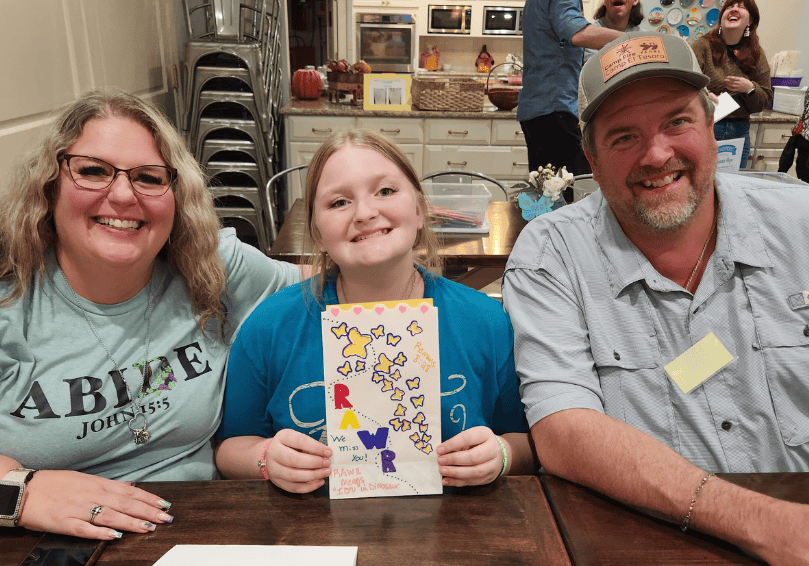When we open our groups each  evening at The WARM Place, we listen to some quiet music to get started. This is a “mindfulness” exercise in which we notice our breath and simply calm ourselves to be present to one another. I think of this as the most important 5 minutes of our evening together. Parents, when asked what they would like more of, often say that they would like more calm or peace in their life. They would like less stress and anxiety. I often suggest that parents practice some mindfulness tools to help relieve stress and anxiety and strengthen their inner calm.
evening at The WARM Place, we listen to some quiet music to get started. This is a “mindfulness” exercise in which we notice our breath and simply calm ourselves to be present to one another. I think of this as the most important 5 minutes of our evening together. Parents, when asked what they would like more of, often say that they would like more calm or peace in their life. They would like less stress and anxiety. I often suggest that parents practice some mindfulness tools to help relieve stress and anxiety and strengthen their inner calm.
Mindfulness has other benefits, too. When parents listen to their children’s sadness, there is a natural tendency to want to cheer them up or to tell them they shouldn’t feel a certain way—sad or angry, for instance. As parents practice mindful listening, they have less need to change their children’s emotions. Parents are more able to listen for understanding their children’s point of view. Children begin to talk to their parents more when they know they are really being heard rather than being asked to change their emotions.
Below are some mindfulness tools that you can practice. Read through all five tools and pick the one that resonates the most with you. Or you may discover a tool of your own that you’d like to practice. Try picking one tool to practice for a week. Then notice how simply being mindful affects your interactions with your grieving children.
-Kathy Telger, WARM Place Counselor
Mindfulness Tools for Coping with Stress
Calming Breath: Close your eyes and get comfortable. Slowly take a deep breath in through your nose to the count of 5, and then slowly breathe out through the nose or mouth to the count of 7. This process gets extra oxygen to the brain and tricks the brain into thinking the body is calm. You may notice your heart rate slow a little. This breathing can be done any time and no one will know you are doing it. Try to focus all your attention on your counting and following your breath as it goes in and out. Repeat at least 3 times. To add to this, you can imagine breathing in peace and calm as you inhale and breathing out stress as you exhale. Say to yourself “May I be at peace.”
Willing Hands: Practice radical acceptance of what you can’t control. Place your hands face up on your lap in a relaxed position. Close your eyes and turn your attention to your breathing. Breathe in counting to 5 and out counting to 7 three times. Identify what aspects of a stressful situation are out of your control. Slowly say to yourself, “I am willing to not be in control of…” (traffic, other people’s thoughts or behavior, what already is fact, knowing the future…) Repeat the phrase you mind most useful while continuing to breathe slowly.
Watch Thoughts Float By: Imagine sitting next to a river in a peaceful spot. Turn your attention to your breath and watch it gently go in and out. Imagine that your thoughts float by like leaves on the river in front of you. Rather than following them as you usually would, imagine letting them simply float by and then return your attention to your breath. You do not need to talk back to the thoughts or engage with them as they pass by. Remember your thoughts are not YOU, or “the Truth.” They are just thoughts. Each time your mind wanders downstream, notice, “This is a thought,” and then practice simply letting it go, over and over again, each time returning to the side of the river, focusing on your breath and letting your thoughts pass by. You may repeat this 100 times as our minds tend to wander. Your job is to keep practicing letting go of thoughts. Each time you successfully identify and let go of a thought, you are practicing changing your normal thinking patterns, seeing thoughts as just thoughts, and not automatically reacting to those thoughts. Try this for 5-10 minutes a day.
Focus on the Present: Use your 5 senses to experience the present as it is happening now. Notice 5 things you can see, 5 things you can hear, and 5 things you can feel. Each time your mind wanders, gently return your attention back to your experience right now. Try this while eating, working, cleaning, walking, listening to music, waiting in line, spending time with a friend or loved one…
Focus on what is most important or meaningful about an activity as it is happening. How is it beneficial to you or someone else? What purpose does it serve? If a situation is difficult, how can you learn from it or be the “best you” right now? Rather than reacting to stress, how can you intentionally act in a way in line with your goals and values? My intention is to…. learn from this situation…benefit others in any way I can…be a supportive/loving/accepting friend/spouse/daughter etc.
Mindfulness Tools for Coping with Stress by Kathryn Soule, MA, LPC
www.SouleTherapy.com
ksoule@souletherapy.com
682-556-4593



